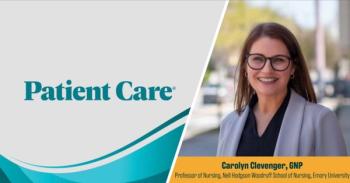
Polypharmacy in Elderly Patients: Practical Tips to Avoid Adverse Effects and Interactions
An 81-year-old woman with a history of moderate Alzheimer dementia, depression, coronary artery disease, hypertension, and type 2 diabetes mellitus was accompanied to the office by her son for a routine follow-up appointment.
THE CASE: An 81-year-old woman with a history of moderate Alzheimer dementia, depression, coronary artery disease, hypertension, and type 2 diabetes mellitus was accompanied to the office by her son for a routine follow-up appointment. She had been taking sertraline for 1 year for treatment of depressive symptoms that included hypersomnia, loss of interest in usual activities, and feelings of hopelessness. The treatment had relieved her symptoms. She had no new complaints, and no changes were made to her regimen.
One week later, the pharmacy reported that the patient's new insurance company would not cover sertraline without prior authorization. Citalopram was substituted.
One month later, the patient's son reported that she had had several episodes of nausea and vomiting during the previous 2 days. These symptoms resolved without intervention. After another 4 weeks, the nausea and vomiting recurred for another 2 days and again resolved without intervention. At a 3-month follow-up appointment, the patient had lost 12 lb, and her son reported that she had neither appetite nor energy. There had been no change in her medications, and the patient's physical and laboratory findings were unrevealing.
Two weeks later, the pharmacy faxed a refill request for sertraline. Further investigation revealed that 4 months previously, the pharmacy had inadvertently added citalopram to sertraline, instead of replacing it. The patient's symptoms resolved when the sertraline was tapered and discontinued.
How can common medication errors in elderly patients be avoided?
Persons aged 65 years or older make up 14% of the population and take more than 30% of prescription drugs.1 Adverse drug reactions are responsible for 5% to 28% of acute geriatric hospital admissions and occur in 35% of community-dwelling elders. The use of multiple medications is associated with a higher likelihood of drug-drug interactions and adverse drug reactions.2 Moreover, there is an increased risk of adverse drug reactions in elderly persons because of pharmacokinetic and pharmacodynamic changes related to aging.3
A recent review concluded that polypharmacy continues to be a significant problem and that little research has been conducted on the methods primary care clinicians use to assess polypharmacy.4
ASSISTANCE FOR CLINICIANS
ACOVE quality indicators.
One of the largest systematic attempts to prevent adverse drug events in older persons is the Assessing Care of Vulnerable Elders (ACOVE) quality indicators for appropriate medical care, which were developed by Pfizer, Inc, and RAND Health (Table 1 [Part 1, Part 2]).5,6 Studies are under way to determine whether the information contained in the group's Fact Sheets has improved the care that physicians provide for these patients. The methods used to develop the quality indicators included literature review and expert panel discussion.
Standardize prescribing practice. When prescribing a new medication, be aware of the expected outcomes, reactions, and interactions and assess and document the condition or symptoms that the medication is intended to treat (Table 2). At subsequent visits, these outcomes can be measured until a therapeutic end point is attained.
To avoid adverse effects, it is crucial to prescribe the appropriate medication at the correct dosage for the condition targeted.
Because of changes in pharmacokinetics and pharmacodynamics in older patients, it is best to avoid starting 2 drugs at the same time. Monitoring for adverse drug events becomes very difficult under these circumstances.
Electronic medical prescription assistance. Computers have enhanced the ability to identify potential medication errors. Pharmacy programs can identify drug interactions, as well as assist with appropriate dosing in patients with renal impairment. Portable programs, such as ePocrates, DrugIx, Lexi-Interact, and the Tarascon Pocket Pharmacopoeia, have built-in medication interaction programs that can be used at the bedside or in the office. ePocrates Rx scored 90% or higher on sensitivity and specificity in detecting clinically important drug-drug interactions.7
Other sources, such as
Using a computerized medication review system that links pharmacists and physicians helps identify potentially dangerous drug interactions.8 At Summa Health System, an "Elder Monitor" program was developed that uses the expertise of the Acute Care of Elders unit interdisciplinary team and the pharmacy computer system to decrease the use of 3 potentially risky drugs in elderly hospitalized patients.9
The Internet is an excellent resource for information on "nutraceuticals" (herbal preparations and nutritional supplements). The use of alternative products is booming in this country, with an estimated $46 billion in sales in 2003. Many of these products have potentially serious side effects. The Internet tends to be more up-to-date than print sources. The electronic databases (Natural Medicine Comprehensive Database, Micromedex, AltMedDex) and an Internet site (The Natural Pharmacist) are considered the most helpful references for information on herbal and dietary supplements. The Natural Therapeutics Pocket Guide is considered the most helpfulbook reference.10,11
PRACTICAL MEASURES
Single pharmacy. Encourage patients to use one pharmacy; this simplifies monitoring for potential drug interactions. The use of one pharmacy is especially important for patients who receive prescriptions from more than one physician. In addition, physicians can check on refill use to monitor medication compliance.
Data about pharmacist interventions are limited. An extensive review of randomized controlled studies before 2003 that involved pharmacy interventions to reduce the incidence of drug-related problems in the elderly revealed only one trial in the community setting.12
Prefilled pillboxes. Some pharmacies offer the option of dispensing medication in prefilled pillboxes that separate doses based on day of the week and time of day, instead of the traditional format of one medication per bottle. This is particularly helpful for patients with memory impairment or those who use multiple medications. If the pharmacy cannot provide this service, patients can call on trusted caregivers to assist in filling and monitoring a pillbox. Other options include automatic dispensers with a voice-activated message or telephone reminders. Several small studies suggest that aids such as these improve adherence.13-15
Avoid hazardous medications. The Beers list of potentially inappropriate medications for elderly patients continues to be updated.16The list, which was initially developed by a consensus panel for nursing home patients, was expanded in 1997 to include all patients older than 65 years. Many of these medications were reviewed recently.3 Avoiding hazardous medications is a key principle in drug prescribing for elderly patients. New medications should not be prescribed until they have been demonstrated to be safer or more effective than existing agents.
Monitor new complaints. Always consider a new complaint as a medication side effect if the timeline is appropriate, even if it is a rare side effect. A medication is sometimes prescribed to treat an adverse drug reaction that is misinterpreted as a new medical condition--the so-called prescribing cascade.17
Drug holidays. At times, polypharmacy becomes so complicated that one might consider a drug holiday if the patient's symptoms are not responding to traditional therapy.This approach is particularly helpful for patients (such as those with Parkinson disease or those taking antipsychotic agents) involved in a prescribing cascade. When patients have complicated medical regimens and ongoing symptoms, a targeted gradual weaning of medications may be appropriate. Those with complicated medical or functional problems may require close observation in a hospital or rehabilitation setting to monitor outcomes of drug withdrawal.
Self-monitoring. Discuss expected outcomes, therapeutic end points, and potential adverse effects with patients and/or their caregivers. Teaching patients to self-monitor for adverse effects is crucial to optimal outcomes. It is helpful to provide written instructions and follow up with phone calls for those who are cognitively impaired or who lack social support.
Patient's status. Drugs are often prescribed without regard to a patient's financial, cognitive, or functional status. This practice may result in increased noncompliance. When possible, consider generic drugs.
Review medications. Review medications at every appointment for potential adverse effects and interactions. "Brown bag" medication reviews are increasingly important as our health care delivery becomes more fractured, with care being given in different settings at different times.5,18,19 Reviewing the actual bottles and counting the number of pills remaining in the container, instead of looking at a simple list, may reveal compliance problems that would not otherwise be identified. Medication reviews may also allow the discontinuation of drugs that are no longer needed, such as antihypertensives for a patient who has lost enough weight to eliminate hypertension. The ultimate medication review would take place in the home setting, where related risk factors could be identified, such as multiple medication storage locations, confusion between generic and trade names, and expired medications.20
COMMENT ON THE CASE
The error in this patient's prescription could have been prevented if the suggestions outlined above had been implemented. A computerized medication review that linked the pharmacy to the physician would have highlighted the fact that 2 selective serotonin reuptake inhibitors were dispensed inappropriately. Some pharmacies send entire lists of medications, even when only 1 refill is being requested. In addition, a brown bag review would have identified the medication error early on. Because neither the patient nor her son was able to accomplish a brown bag review, the patient's pharmacy was contacted after every visit to review current medications.
References:
REFERENCES:
1.
Chrischilles EA, Foley DJ, Wallace RB, et al. Use of medications by persons 65 and over: data from the established populations for epidemiologic studies of the elderly
. J Gerontol.
1992;47:M137-M144.
2.
Field TS, Gurwitz JH, Harrold LR, et al. Risk factors for adverse drug events among older adults in the ambulatory setting
. J Am Geriatr Soc.
2004;52:1349-1354.
3.
Cefalu CA. Drug therapy in elderly patients: how to avoid adverse effects and interactions.
Consultant
. 2006;46:1545-1552.
4.
Fulton MM, Allen ER. Polypharmacy in the elderly: a literature review.
J Am Acad Nurse Pract.
2005;7:123-132.
5.
Knight EL, Avorn J. Quality indicators for appropriate medication use in vulnerable elders
. Ann Intern Med
. 2001;135:703-710.
6.
Shekelle PG, MacLean CH, Morton SC, Wenger NS. Assessing care of vulnerable elders: methods for developing quality indicators.
Ann Intern Med
. 2001;135:647-652.
7.
Perking NA, Murphy JE, Malone DC, Armstrong EP. Performance of drug-drug interaction software for personal digital assistants.
Ann Pharmacother
. 2006;40:850-855.
8.
Monane M, Dipika MM, Nagle BA, Kelly MA. Improving prescribing patterns for the elderly through an online drug utilization review intervention: a system linking the physician, pharmacist, and computer.
JAMA
. 1998;280:1249-2152.
9.
Fosnight SM, Allen KR, Holder CM, Hazelett S. A strategy to decrease the use of risky drugs in the elderly.
Clev Clin J Med
. 2004;71:561-568.
10.
Sweet BV, Gay WE, Leady MA, Stumpf JL. Usefulness of herbal and dietary supplement references.
Ann Pharmacother
. 2003;37:494-499.
11.
Walker JB. Evaluation of the ability of seven herbal resources to answer questions about herbal products asked in drug information centers
. Pharmacotherapy
. 2002;22:1611-1615.
12.
Hanlon JT, Lindblad CI, Gray SL. Can clinical pharmacy services have a positive impact on drug-related problems and health outcomes in community-based older adults?
Am J Geriatr Pharmacother
. 2004;2:3-13.
13.
Barat I, Andreasen F, Damsgaard EM. The consumption of drugs by 75-year-old individuals living in their own homes.
Eur J Clin Pharmacol
. 2000;56:501-509.
14.
Barat I, Andreasen F, Damsgaard EM. Drug therapy in the elderly: what doctors believe and patients actually do.
Br J Clin Pharmacol
. 2001;51:615-622.
15.
Littenberg B, MacLean CD, Hurowitz L. The use of adherence aids by adults with diabetes: a cross-sectional survey.
BMC Fam Pract
. 2006;7:1.
16.
Fick DM, Cooper JW, Wade WE, et al. Updating the Beers criteria for potentially inappropriate medication use in older adults: results of a US consensus panel of experts.
Arch Intern Med.
2003;163:2716-2724.
17.
Rochon PA, Gurwitz JH. Optimising drug treatment for elderly people. The prescribing cascade.
BMJ.
1997;315:1059-1061.
18.
Nathan A, Goodyer L, Lovejoy A, Rashid A. "Brown bag" medication reviews as a means of optimizing patients' use of medication and of identifying potential clinical problems.
Fam Pract
. 1999;16:278-282.
19.
Boockvar KS, Carlson LaCorte H, Giambanco V, et al. Medication reconciliation for reducing drug-discrepancy adverse events.
Am J Geriatr Pharmacother
. 2006;4:236-243.
20.
Sorensen L, Stokes JA, Purdie DM, et al. Medication management at home: medication risk factor prevalence and inter-relationships.
J Clin Pharm Ther
. 2006;31:485-491.
Newsletter
Enhance your clinical practice with the Patient Care newsletter, offering the latest evidence-based guidelines, diagnostic insights, and treatment strategies for primary care physicians.


















































































































































































































































































